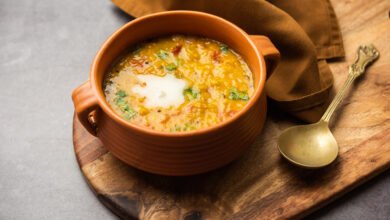Is Dosa Good for Weight Loss? Let’s Find Out- HealthifyMe

Fermented foods, like idli and dosa, contain beneficial bacteria called probiotics. These probiotics can help improve gut health by promoting the growth of beneficial gut bacteria. Furthermore, it helps maintain a healthy balance of microorganisms that improve digestion and lead to a more robust immune system.
Fermented foods contain enzymes that aid in the digestion of food, making it easier for the body to absorb nutrients. Additionally, fermented foods are often higher in vitamins and minerals than non-fermented foods. Also, the fermentation process can break down and make these nutrients more bioavailable.
Eating a diet rich in fermented foods can also help reduce inflammation. As a result, it can positively impact several chronic health conditions, including obesity, heart disease, and diabetes. However, consuming fermented foods in moderation is vital for overall health. Unfortunately, excessive intake can cause side effects like bloating, gas or even an allergic reaction for some individuals.
Dosa is both tasty and nutritious. However, preparation methods also play a role. Plain dosa is relatively healthier as there’s no filling, just a simple savoury pancake.In today’s culinary world, dosa is prepared in several ways, from using ragi, oats and other nutritious grains. These varieties are lower in carbs and better suited for weight loss..
This article explores everything you must know about this popular Indian staple.
Dosa: An Overview
A dosa, also known as a Dosai or a Dosha, resembles a thick pancake or a crispy Indian-style crepe prepared from a fermented batter of crushed rice and black lentils. Dosas are usually served hot with chutney and sambar. It can be consumed for breakfast, as a snack or whenever you want.
The dosa was first mentioned in Tamil literature in 1054 AD by Chalukya King Somesvara III. Since the 5th century AD, crispy dosas have been a staple in southern India. Dosa is possibly the one snack item in India that has cut across geographical and cultural divides. It is available in malls, restaurants, 5-star hotels and street-side stalls. A truly Indian-Global food, dosa can be part of a weight loss diet if eaten judiciously.
Can I Eat Dosa During Weight Loss Journey?
The standard dosa that one could find in restaurants or on food trucks on the street may contain high-calorie components like butter, oil, etc. In addition, some of the extras, including chutneys, are unhealthy with too many additives. For example, coconut chutney made with refined oils and too much tadka may make you gain weight. Therefore, choose a dosa you cook at home over one with more saturated fats. Dosas made from healthy ingredients could provide sufficient fibre and lessen your cravings.
Dosa Benefits for Weight Loss
Dosa is a delicious breakfast dish that gives your day a nutritious start.. It can be a good option for weight loss as it is high in protein and fibre. Additionally, the fermentation process used to make dosa can improve digestion and make it easier for the body to absorb nutrients. However, please note the quantity of oil and fillings you put in dosa can vary the calorie count making it unsuitable for weight loss.. Ensuring a balanced diet and regular exercise are essential factors in weight loss.
Dosa, made using less oil and healthier stuffings/ toppings (like dill leaves, coriander and grated carrot), can be an ideal option for weight loss. Coconut chutney and vegetable sambar are popular accompaniments to dosa. One gets protein, carbs, good fats and fibre from this meal.
Consuming a balance of protein, fibre, fat, and carbohydrates can help support weight loss for several reasons:
- Protein: Eating enough protein can help promote feelings of fullness. As a result, it reduces overall calorie intake. It also helps to preserve muscle mass while losing fat.
- Fibre: Foods high in fibre can help promote feelings of fullness, reduce calorie intake, and improve digestion.
- Fat: Eating healthy fats can help promote feelings of fullness and provide essential nutrients such as omega-3 fatty acids.
- Carbohydrates: Carbohydrates provide energy for the body. One should include it in a balanced diet.
Eating a balance of these macronutrients can help support weight loss. It provides the body with essential nutrients while promoting feelings of fullness and reducing overall calorie intake.
Typically Made From Urad Dal
Urad dal and rice are the main components of the dosa you make at home. The urad dal becomes nutritious after fermenting for at least a few hours. Consuming dosa prepared from urad dal provides your body with healthy carbs.
Good Source of Iron and Calcium
Urad dal in dosa could give you iron and calcium to meet your energy needs. According to a study, those who consume enough calcium can experience healthy weight loss.
Low Calorie-food
Dosa is a fantastic alternative to reducing your intake of saturated fats. In addition, very little oil or ghee is required for preparing dosa at home. Some also use nonstick pans. Selecting cold-pressed coconut oil or homemade cow ghee adds healthy fats.
High-fibre Content Reduces Appetite.
Oats dosa or ragi dosa are rich in fibre. Furthermore, fibre helps you overcome cravings. Consuming fibre-rich foods as breakfast may help you control your appetite. As a result, you will feel satisfied longer and eat less unhealthy food overall.
The HealthifyMe Note
The traditional dosa is made with urad dal. It is low in calories. It is a good source of iron, calcium, and fibre. Therefore, an ideal food option for dieters. Dosa made with healthy alternatives is a fantastic option for weight loss.
Best Types of Dosa for Weight Loss
Dosa can be incredibly low in saturated fats. Additionally, this breakfast is high in carbohydrates. So, even if you follow a strict eating plan, you can still obtain the energy you need. Furthermore, making dosas from a variety of healthful foods may not only aid in weight loss but also improve your overall health. The following are some dosa variants that are beneficial for losing weight:
Masala Dosa
Masala dosa is made from a fermented batter of rice and lentils, which provides a good source of carbohydrates and protein. The dosa filling, typically made from potatoes, onions, and spices, provides additional nutrients such as fibre and potassium. It is served with sambar and chutney, made from vegetables and lentils. They are good sources of fibre, vitamins and minerals.
It is essential to note that the nutritional value of masala dosa can vary depending on the ingredients used and the cooking method. In addition, some variations may be high in calories and fat due to the use of oil in the cooking process. Nevertheless, Masala dosa can be a nutritious and tasty dish when consumed in moderation and as part of a balanced diet.
Wheat Dosa
This version of dosa has coarsely ground wheat in its husky form. Besides, unlike other types, this dosa batter includes rice flour, some rava, buttermilk and water for great consistency. Thus, you can expect a spicy yet yummy dosa.
Studies suggest whole-wheat promotes weight management. Besides, buttermilk is also healthy for people wanting to shed a few extra pounds. Thus, a wheat dosa is good for weight loss. Moreover, investigations show a whole grain-rich diet assists in weight loss.
Oats Dosa
Oats are inevitably one of the best options when you want to lose weight. Being highly nutritious, it is also great for weight management. Studies prove that oats help burn fats due to their low calories and high fibre content. One can easily make it by grinding oats and adding semolina, rice flour and water to make a batter with good consistency. Moreover, one can even add other veggies like onion, ginger, dill and coriander.
Ragi Dosa
Finger millets from which ragi flour gets made are full of nutrients. Among other nutrients, ragi dosa has good fibre content. You can mix ragi flour, yoghurt, buttermilk and water. The taste of this dosa intensifies with the precise roasting time. Consuming ragi helps your body absorb nutrients slowly, according to studies. In addition, research shows ragi is high in fibre. As a result, there is a decrease in appetite and therefore better weight management.
Moong Dal Dosa
According to research, legumes help with weight loss. Moong dal being a legume, thus will aid in weight management. Moong Dal dosa is tasty and filling where in the moong dal must be steeped for three to four hours before being combined with water to create the batter. Additionally, the batter can also include rava. Rava dosas can aid in weight loss when served with moong dal.
Conclusion
Dosa is one of the most common breakfast items in the Southern part of India. Homemade dosas are the best options for weight loss because you can make them with ragi, oats flour and an increased ratio of lentils. Moreover, control the amount of oil used and portions consumed. Ensure the sambhar has a healthy mix of vegetables and coconut chutney has roasted tadka; a key tip to minimising fats.
Being overweight and obese is a phenomenon that is increasing worldwide. These factors affect your body’s flexibility and make you more susceptible to other health problems. Therefore, it would be best if you took action by improving your diet and physical activity, that is a healthier lifestyle. With HealthifyMe, you can take a significant step towards achieving this. The app essentially serves as your health coach, guiding you to make healthier lifestyle choices, to better manage weight, diabetes, and other lifestyle conditions.
The Supporting Sources
1. Maki KC, Palacios OM, Koecher K, Sawicki CM, Livingston KA, Bell M, Nelson Cortes H, McKeown NM. The Relationship between Whole Grain Intake and Body Weight: Results of Meta-Analyses of Observational Studies and Randomized Controlled Trials. Nutrients. 2019 May 31;11(6):1245. doi: 10.3390/nu11061245. PMID: 31159235; PMCID: PMC6627338.
https://www.ncbi.nlm.nih.gov/pmc/articles/PMC6627338/
2. Li X, Cai X, Ma X, Jing L, Gu J, Bao L, Li J, Xu M, Zhang Z, Li Y. Short- and Long-Term Effects of Wholegrain Oat Intake on Weight Management and Glucolipid Metabolism in Overweight Type-2 Diabetics: A Randomised Control Trial. Nutrients. 2016 Sep 7;8(9):549. doi: 10.3390/nu8090549. PMID: 27618090; PMCID: PMC5037534.
https://www.ncbi.nlm.nih.gov/pmc/articles/PMC5037534/
3. Wu WC, Inui A, Chen CY. Weight loss induced by a whole grain-rich diet is through a gut microbiota-independent mechanism. World J Diabetes. 2020 Feb 15;11(2):26-32. doi: 10.4239/wjd.v11.i2.26. PMID: 32064033; PMCID: PMC6969707.
https://www.ncbi.nlm.nih.gov/pmc/articles/PMC6969707/
4. Devi PB, Vijayabharathi R, Sathyabama S, Malleshi NG, Priyadarisini VB. Health benefits of finger millet (Eleusine coracana L.) polyphenols and dietary fibre: a review. J Food Sci Technol. 2014 Jun;51(6):1021-40. doi: 10.1007/s13197-011-0584-9. Epub 2011 Nov 22. PMID: 24876635; PMCID: PMC4033754.
https://www.ncbi.nlm.nih.gov/pmc/articles/PMC4033754/
5. Polak R, Phillips EM, Campbell A. Legumes: Health Benefits and Culinary Approaches to Increase Intake. Clin Diabetes. 2015 Oct;33(4):198-205. doi: 10.2337/diaclin.33.4.198. PMID: 26487796; PMCID: PMC4608274.
https://www.ncbi.nlm.nih.gov/pmc/articles/PMC4608274/
6. Desai, Anuradha & Kulkarni, Sharduli & Sahoo, A. & Ranveer, Dr. Rahul & Dandge, Padma. (2010). Effect of Supplementation of Malted Ragi Flour on the Nutritional and Sensorial Quality Characteristics of Cake. Advance Journal of Food Science and Technology. 2. 67-71.
7. Eilat-Adar S, Xu J, Loria C, Mattil C, Goldbourt U, Howard BV, Resnick HE. Dietary calcium is associated with body mass index and body fat in American Indians. J Nutr. 2007 Aug;137(8):1955-60. doi: 10.1093/jn/137.8.1955. PMID: 17634270; PMCID: PMC4182955.




